HGST Deskstar NAS 4 TB Review
by Ganesh T S on November 22, 2014 2:00 PM ESTRAID-5 Benchmarking - Miscellaneous Aspects
Consumers are rightly worried about RAID rebuilds and the scope for drive failures during that process. As one of our evaluation aspects, we randomly yanked out a disk during operation and cleaned it up for rebuild. We recorded the resync duration (time taken to rebuild a 3-disk RAID-5 volume when one of the disks needs to be replaced) as well as the average power consumption during that process. The two aspects, considered together, give an idea of the efficiency of the hard drive. The graph below presents the total energy consumption (Resync Power Consumption (W) X Resync Duration (s)) for the resync.
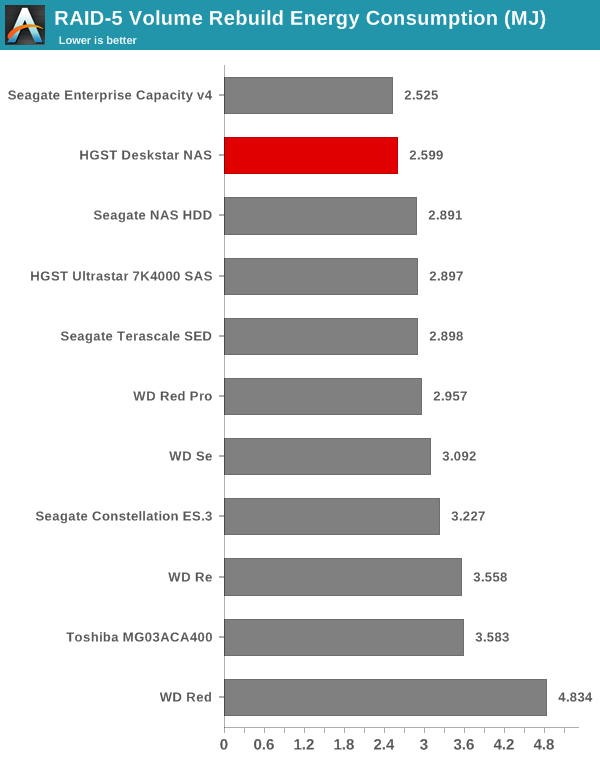
While the energy consumption aspect provides a consolidated view of the various factors, it is still worthwhile to look at the power consumption and resync duration numbers separately. The table below provides the raw information behind the above graph. The HGST Deskstar NAS is not the most power efficient, but makes up for the higher power consumption by getting the job done much faster than the drives with better power numbers.
| RAID-5 Resync Power Consumption & Duration | ||
| Drive | Power (W) | Duration (s) |
| HGST Deskstar NAS | 100.25 | 25922 |
| WD Red | 87.7 | 55125 |
| WD Red Pro | 102.72 | 28787 |
| Toshiba MG03ACA400 | 99.84 | 35886 |
| WD Se | 102.07 | 30293 |
| Seagate Enterprise Capacity v4 | 98.38 | 25670 |
| Seagate NAS HDD | 92.82 | 31149 |
| Seagate Terascale SED | 92.8 | 31230 |
| WD Re | 102.09 | 34850 |
| Seagate Constellation ES.3 | 102.37 | 31520 |
| HGST Ultrastar 7K4000 SAS | 98.35 | 29456 |
We also measured power consumption during the last stage of our multi-client test. With 25 different clients simultaneously stressing the NAS with different types of workloads, we recorded the power consumption at the wall for the NAS as a whole. The various numbers are presented in the graphs below.
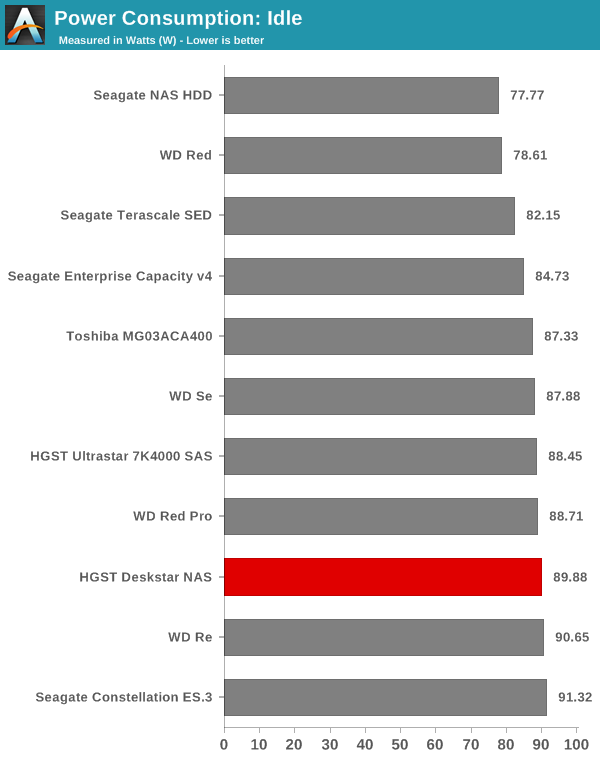
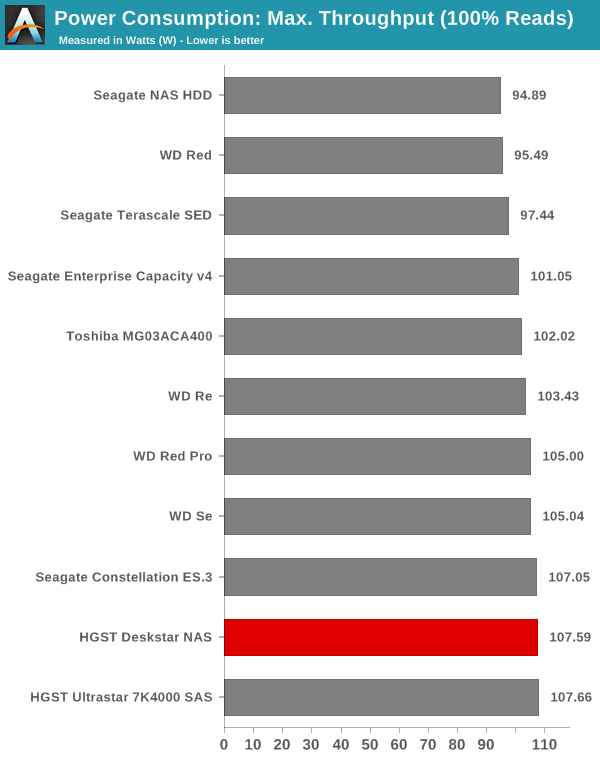
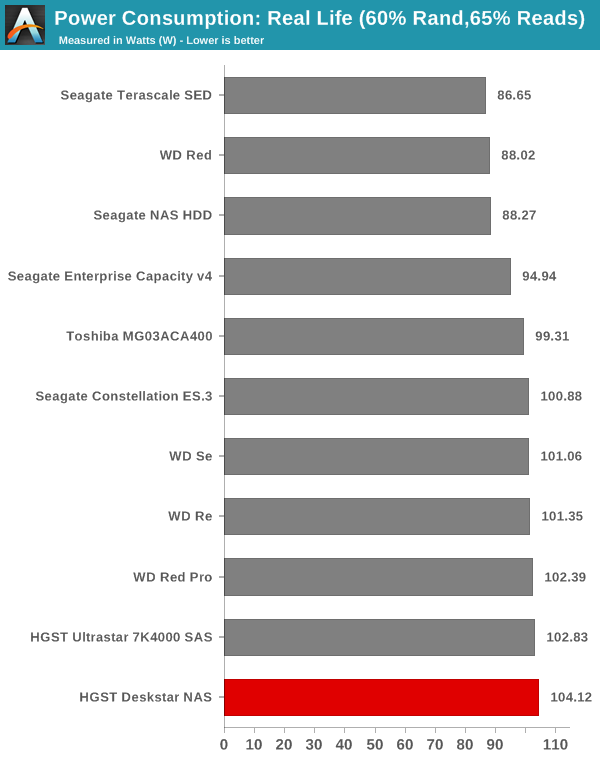
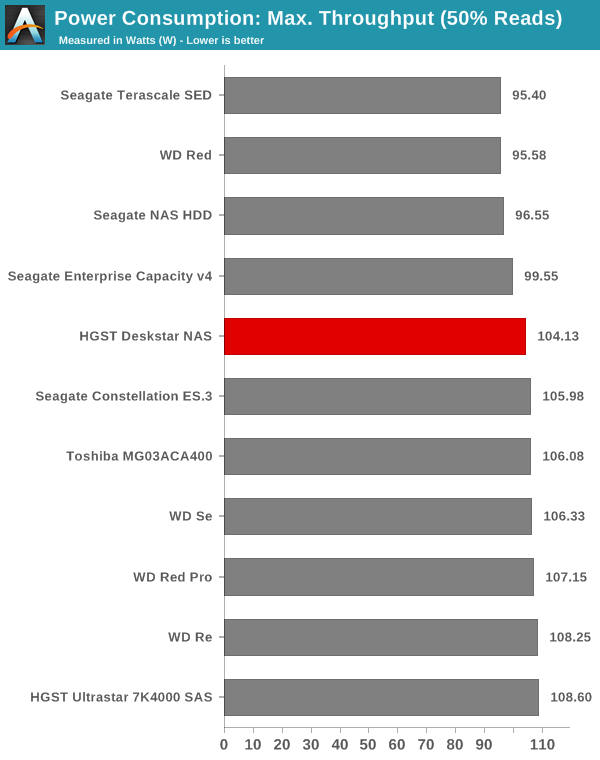
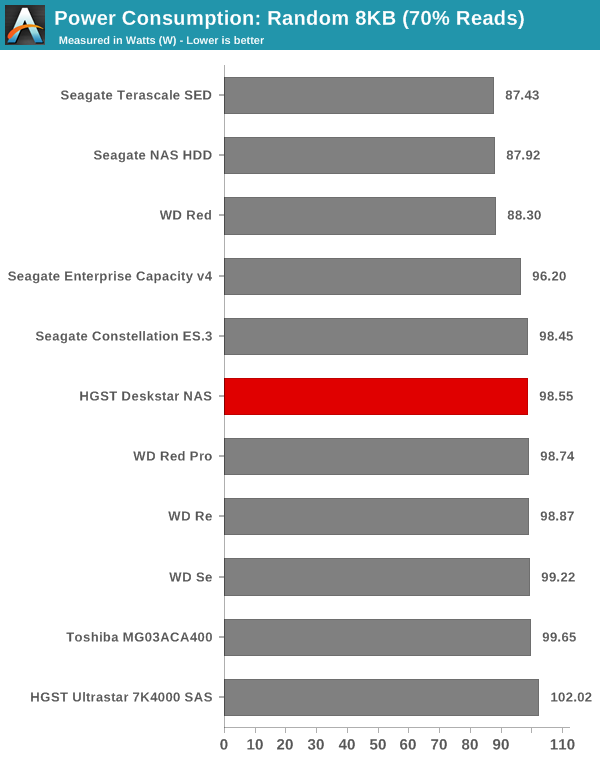
As expected, the units providing better performance have higher power consumption numbers. The HGST Deskstar NAS could be a bit more power efficient, particularly since units such as the Seagate Enterprise Capacity v4 manage to deliver similar / better performance with a better power consumption profile.










39 Comments
View All Comments
Sabresiberian - Saturday, November 22, 2014 - link
The Deskstar looks like a good choice for its purpose, but I have to wonder why it is the only one in the bunch with a 3-yr warranty instead of 5-yr.cen - Saturday, November 22, 2014 - link
I checked WD Red 4TB and Seagate NAS 4TB and both have 3 year warranty. Mind to explain?ganeshts - Saturday, November 22, 2014 - link
I double-checked my tables and indeed the Red and the NAS HDD have only 3 year warranties. Basically, 5 year warranties are only for enterprise-targeted drives (and the WD Red Pro).In effect, the extra $15 for the Deskstar NAS is only for the extra RPM / performance. If you need a 5-year warranty, you need to go the enterprise drive route.
Samus - Sunday, November 23, 2014 - link
Because you don't need a 5 year warranty with these drives. I point you to a study outside the scope of Anandtech's capacity:https://www.backblaze.com/blog/hard-drive-reliabil...
Having used Hitachi drives in multiple applications from IO intensive NAS to cold storage, the results Backblaze has match my own. The 75GXP days are long passed us, and from here, all we can hope is WD (my second go-to manufacture for drives, and owner of HGST) will use Hitachi technology. Seagate has fallen apart from their prime "Barracuda 7200.7" days. I pulled one of those out of a desktop a year ago, it was a decade old and still quiet as a kitten. 95,000 hours on it, 4,000 power cycles. Simply amazing for a consumer class drive.
josue16 - Monday, November 24, 2014 - link
Thanks for the link. I was looking for this.Laststop311 - Sunday, November 23, 2014 - link
sabresiberian the warranties aren't everything. Hitachi has the lowest failure rate in my experience and in googles experience and I'm sure the link samus gave will also say that i dont even need to look because it's just a fact hitachi's are like the energizer battery they keep going and going and going...CaedenV - Tuesday, November 25, 2014 - link
the warranty that you never have to use is by far the best warranty. Especially when it comes to data storagechrcoluk - Saturday, October 20, 2018 - link
not to mention what value is a warranty on a hdd, warranties dont recover lost data.HGST drives are the best on the market, I just wished they made 5400rpm models as a 7200rpm drive is louder.
Just because something has a longer warranty it doesnt mean it will last longer, warranties are used as a marketing tool now days.
Laststop311 - Sunday, November 23, 2014 - link
Well in my 20 years of dealing with pc's I've gone through many hard drives from many manufacturers and I can confidently say Hitachi has given me the fewest problems of all the current manufacturers. If i had to rank them I would say Seagate has been the absolute worst for me by far. They are so bad I once had a drive fail the warranty replacement fail within a month then the replacement to that replacement fail in the first week. Many other seagates failed too I've had over a dozen seagate failures in 20 years. Next worse would be Toshiba i think about 5 ot 6 toshiba drives have failed on me. Samsung about the same 5 or 6 failures. Western digital has done me pretty well i can only think of 3 times a WD drive has failed on me. Now hitachi only once. I have a 120GB hitachi drive that is going strong still the thing wont die. I have a stack of old hitachi drives that still work fine just have no use for such low densities. I dont know if its random luck or chance but I have nothing but good times with hitachi drives. Google seems to agree I read a report for them where they had a HUGE data sample on drive failure rates and hitachi was number 1 for them too with lowest failure rates of all brands. I don't think it is luck, Hitachi just really makes the best hard drives. I just hope this reliability does not change because WD bought them. But at least they were bought by WD and not some 1 else as WD isn't terrible like seagate and toshiba and samsung especially seagate, buying a seagate is throwing your money away.vol7ron - Wednesday, November 26, 2014 - link
I'm sure experience would vary based on how many drives you own, what density the drives are, where you live or where the drives are located (external environment / thermals), what kind of actions the system is doing, OS / BIOS setup.There's a lot of factors, which is why its tough to draw from a person's experience and why it's more suitable to go to sites that have testbeds set up.
The reason I'm commenting because I thought it was Seagate or Hitatchi that had something that became the "DeathStar" because the drives would always fail. Vendors have had bad batches of products, but also good batches. They're almost like cars, so you have to make sure you're getting one of the better quality ones the manufacturer is putting out and not judge the manufacturer based on all the models they're making. Just like wine, some years are better than others.